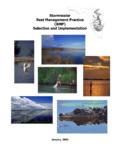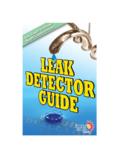Transcription of A Guide t o - Florida Friendly Landscaping, Florida Plants ...
1 A Guide toFlorida-FriendlyLandscapingFlorida Yards &Neighborhoods HandbookCreate a Florida - Friendly YardYards and landscapes can be a positive asset to Florida . You can design and maintain your own Florida - Friendly Yard by following the simple, common sense practices in this book. You will learn the basics of designing a landscape featuring carefully selected Plants suited to Florida s unique climate, natural conditions and wildlife. We offer you cost-saving tips that, if implemented prop-erly, will help you reduce water, fertilizer and pesticide use. There is also a helpful section for waterfront homeowners that addresses the special concerns of shoreline landscape management.
2 Whether you are starting from scratch with a new land-scape or considering changes to an existing yard, the Florida Yards & Neighborhoods Handbook offers helpful concepts, tools and techniques for creating your own Flor-ida- Friendly Yard. We hope you enjoy the publication and we look forward to assisting you in creating an aesthetically pleasing landscape that will also help to protect Florida s natural .eduContributors and Reviewers:Amy Alexander, Dale Armstrong, Ben Bolusky, Eileen Buss, Chris Claus, Patty Connolly, Dan Culbert, Tracy Floyd, Allen Garner, Jennifer Gillett, Edward Gilman, Hugh Gramling, Paul Hinchcliff, Mike Holsinger, Mary Hoppe, Adrian Hunsberger, Carol Keiper-Bennett, Christine Kelly-Begazo, William H.
3 Kern, Jr., Gary Knox, Barbra Larson, Mickey MacDonald, David Marshall, Julie Martens, Rebecca McNair, Russell Mizell, Terril Nell, Sydney Park-Brown, Marina Pryce, Gale Robinson, Kathleen Ruppert, Fred Santana, Michael Scheinkman, Bart Schutzman, Mark Shelby, Heidi Smith, John Stevely, Michael Thomas, Laurie Trenholm, Brian Unruh, Teresa Watkins, Celeste White, Tom Wichman and Ray was also provided by a grant from the Southwest Florida Water Management District. District staff contributed signifi cantly to the design and layout of this Edition, Published 2006 Florida Yards & NeighborhoodsUniversity of Florida , Institute of Food and Agricultural Sciences (UF/IFAS) Environmental Horticulture Dept.
4 , Box 110675, Gainesville, FL 32611-0675(352) 392-1831, ext. of this text may be reproduced for non-commercial use only. This booklet was funded in part by a Section 319 Nonpoint Source Management Program Implementation grant from the Environmental Protection Agency through a contract with the Nonpoint Source Management Section of the Florida Department of Environmental Protection. COOPERATIVE EXTENSION SERVICE, UNIVERSITY OF Florida , INSTITUTE OF FOOD AND AGRICULTURAL SCIENCES, Larry R. Arrington, Director, in cooperation with the United States Department of Agriculture, publishes this information to further the purpose of the May 8 and June 30, 1914 Acts of Congress; and is authorized to provide research, educational information and other services only to individuals and institutions that function with non-discrimination with respect to race, creed, color, religion, age, disability, sex, sexual orientation, marital status, national origin, political opinions or affi liations.
5 Single copies of extension publications (excluding 4-H and youth publications) are available free to Florida residents from county extension offi ces. This information was originally published November 1994 as Bulletin 295, Florida Cooperative Extension Service. Revised March 1996 as SP-191. Revised 2003, Yards and Neighborhoods:For Additional Information:For references on the information contained in this book and links to additional resources on each of the nine Florida - Friendly landscaping principles, including many articles on the EDIS website (Electronic Data Information Source of UF/IFAS Extension), go to .edu and follow the link to the FYN Handbook.
6 You can also visit for more information on Florida - Friendly landscaping , or contact your county s UF/IFAS Extension offi ce and ask for the Florida Yards & Neighborhoods program. See .edu/offi or check the government pages in your phone book to fi nd your county s Extension offi Ponds A common pond type and perhaps the easiest to imitate as a yard feature is a shallow seasonal pond, typically 2' 5' deep and 25' 150' across. Variations in seasonal rainfall cause fl uctuations in water level, appearance and function. In winter, standing water recedes, often drying down completely, depending on the pond s water depth, soil type and the local water table.
7 But even in this dry-down condition, a seasonal pond offers moisture sources, the damp habitats required by many amphibians, reptiles, birds and small mammals. If you wish to construct a pond to replicate these important habitats, choose an area that:n accommodates the shallow and wide profi len already contains suitable plant life and soil types n provides access for wildlife Conclusions: Connecting Our Yards to Florida 's WaterwaysThe future of Florida s treasured water resources begins in your yard. The decisions you make from developing a home site, to landscaping your yard, to fertilizing your lawn actually infl uence the health of Florida s natural waterways.
8 Nature doesn t recognize property lines. A rainstorm can wash bare soil, landscape debris, gas, oil, fertilizers or pesticides from one yard to another. A butterfl y attracted to one person s wildfl owers can fl it across a property line into another landscape. Landscapes do not just connect people to the outdoors; they also connect one person s property to the next, forming neighborhoods. Ultimately, yards and neighborhoods are connected to water resources. This connection may be immediate, as in a waterfront community, or gradual, through the fl ow of storm drains, ditches, streams, rivers and ground water. For more information on Florida - Friendly landscaping , contact the FYN Coordinator at your county's UF/IFAS Extension offi ce (fi nd contact information at.)
9 Edu) or visit the state FYN website at . , Locate Your Watershed: .edu TABLE OF CONTENTS About the FYN How to Use This Florida Neighborhoods: Connecting Our Yards to Florida 's Creating Your Florida - Friendly Florida - Friendly landscaping Principles: 2 Water Effi 3 Fertilize 5 Attract 4 6 Manage Yard Pests 7 Recycle Yard 8 Reduce Stormwater 9 Protect the 1 Right Plant, Right landscaping : Shallow ponds, typical in Florida ,allow sunlight to penetrate the you fi nd yourself managing one of these natural stormwater fi ltration systems, follow our do s and don ts checklist to maintain them properly.
10 POND MANAGEMENT DO sn DO plant appropriate aquatic, emergent and upland vegetation they stabilize soil DO use pond water for non-potable irrigation DO fertilize surrounding areas with the least amount of fertilizer possible, always using a slow-release type. n DO use organic compost in lieu of fertilizer. n DO use mulch around Plants to retain moisture. n DO keep pet wastes out of water bodies. POND MANAGEMENT DON TSn DON T allow livestock to graze pond bank sides. n DON T swim in or eat fi sh caught in stormwater ponds. n DON T allow invasive Plants to clog waterways. n DON T direct grass clippings into stormwater ponds. About the Florida Yards & Neighborhoods (FYN) ProgramThe Florida Yards & Neighborhoods (FYN) program is a partnership of the University of Florida /Institute of Food and Agricultural Sciences (UF/IFAS), Florida s water management districts, the Florida Department of Environmental Protection (FDEP), the National Estuary Program, the Florida Sea Grant College Program, concerned citizens, members of private industry and numerous other nongovernmental agencies.





